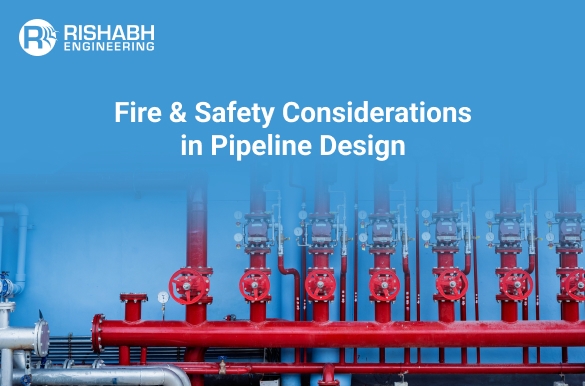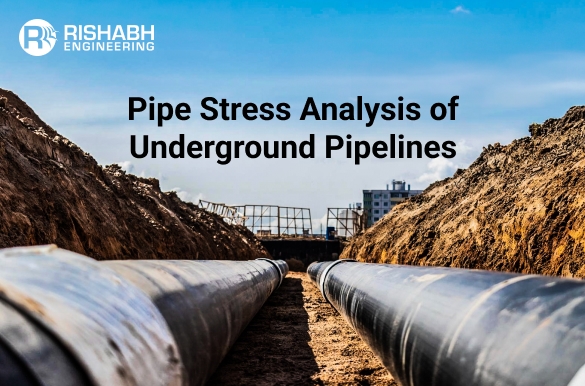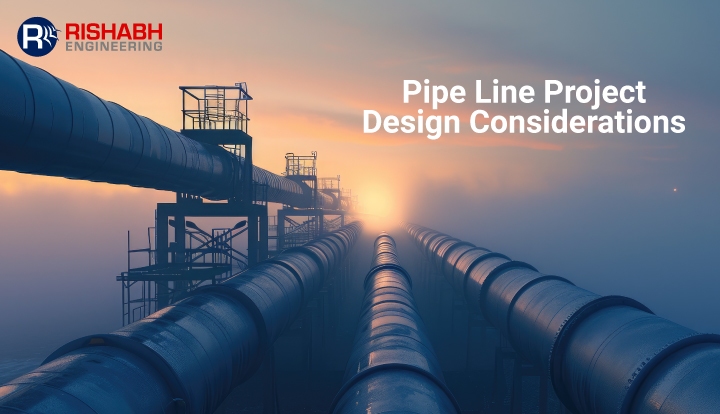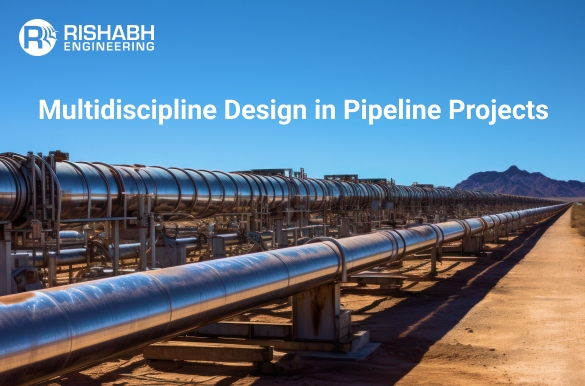
Fire Safety in Pipeline Infrastructure: Key Considerations and Design Practices
An essential component of the transportation of energy resources, such as natural gas, oil, and processed goods, is pipeline infrastructure. These methods do carry some danger, though. Operational integrity, environmental health, and human safety can all suffer greatly from fires, explosions, and leaks. As a result, every phase of pipeline design, construction, and operation must give top priority to fire and safety concerns.
The intricacies and difficulties related to pipeline infrastructure safety and fire are recognized by Rishabh Engineering. Utilizing our diverse design skills, we implement industry’s best practices to improve safety, reduce the danger of fire, and guarantee regulatory compliance. This article examines important pipeline fire safety factors and design techniques that reduce pipeline infrastructure fire hazards, emphasizing Rishabh Engineering’s contributions to safer systems.

Understanding Fire Risks in Pipeline Infrastructure
The transportation of flammable substances poses inherent risks, such as:
- Leakage and Spillage: Corrosion, mechanical failures, or improper handling can lead to leaks, creating fire hazards.
- Overpressure Scenarios: Excessive pressure within the pipeline can cause ruptures, resulting in explosions or fires.
- External Hazards: Third-party damage, natural disasters, or vandalism may increase the risk of ignition.
- Operational Errors: Inadequate monitoring, poor maintenance, or mismanagement of flow rates can exacerbate risks.
Given these challenges, fire safety must be embedded in the engineering and design processes to ensure pipeline integrity and minimize fire-related incidents.
Key Fire Safety Design Practices in Pipeline Infrastructure
1. Pipeline Routing and Layout Optimization
The location and routing of pipelines significantly impact on fire safety. Rishabh Engineering employs advanced tools and methodologies to design pipeline layouts that mitigate risk:
- Steer Clear of High-Risk locations: Building pipelines away from dense populations, delicate ecosystems, and high-risk locations reduces the chance of fire and guarantees safer operations.
- Buffer Zones: By keeping pipes and surrounding structures at safe distances, such incidents are less likely to occur and have a smaller impact.
- Hydraulic Analysis: To optimize pipeline configurations and guarantee safe operation under a range of circumstances, our engineers conduct stress and flow analyses using software such as CAESAR II.
2. Material Selection and Corrosion Prevention
Material selection is a crucial determinant of pipeline safety. We ensure the use of materials that meet fire resistance and durability requirements:
- Fire-Resistant Coatings: The related infrastructure is shielded from high temperatures and ignition is postponed by applying fireproof coatings.
- Alloys that Resist Corrosion: Choosing materials that are resistant to rust reduces the possibility of leakage, particularly in abrasive conditions.
- Cathodic Protection Systems: The installation of cathodic protection devices helps shield pipes from corrosion over time.
3. Fire and Gas Detection Systems
Risk reduction requires early identification of possible fire dangers. Modern gas and fire detection systems are incorporated into pipeline constructions by our team:
- Infrared and ultrasonic detectors: These tools facilitate the timely detection of leaks and anomalous heat patterns.
- Constant Monitoring: The teams may guarantee real-time pipeline condition monitoring by utilizing SCADA (Supervisory Control and Data Acquisition) technologies.
- Automatic Shut-Off Valves: To stop leaks and stop a fire from getting worse, strategically positioned valves isolate impacted areas.
4. Pipeline Integrity Management
Preventive maintenance and regular inspections are vital for ensuring pipeline safety. Our multidisciplinary engineering team designs systems with robust integrity management protocols:
- Non-Destructive Testing (NDT): Methods such as magnetic flux leakage and ultrasonic testing are examples of NDT that can find weaknesses without interfering with current operations.
- Predictive Analytics: Our design teams use data insights to foresee possible problems and suggest fixes to stop mishaps before they happen.
- Solutions for Remote Monitoring: IoT-enabled sensors offer real-time information on pipeline conditions, facilitating proactive safety management and successfully reducing risks.
5. Mitigation Measures for Fire Incidents
Should an incident occur, it is crucial to minimize damage and ensure the safety of personnel and assets. Our team incorporates the following mitigation measures:
- Fire Suppression Systems: Creating foam-based suppression, water spray, and deluge systems according to pipeline specifications.
- Emergency Response Plans: Creating comprehensive emergency response plans that include methods for fire containment, evacuation, and collaboration with local authorities is known as emergency response planning.
- Thermal Insulation: Adding thermal barriers to stop heat transmission and lower the chance of a fire spreading is known as thermal insulation.
Pipeline Fire Safety Regulations
Ensuring compliance with international and regional fire safety regulations is a cornerstone of pipeline design. Our specialization includes adherence to standards such as:
- ASME B31.4: Managing liquid and slurry pipe transportation systems.
- API RP 521: Handling Depressuring and Pressure-Relieving Systems.
- NFPA Standards: Including NFPA 59A for LNG plants and NFPA 30 for flammable liquids.
- ISO 31000: Guidelines for risk management to guarantee thorough hazard assessment.
Pipeline Fire Safety Considerations: Rishabh Engineering’s Approach
Ensuring fire safety during pipeline infrastructure design is essential for protecting people, the environment, and property. These crucial factors are addressed in the following ways by multidisciplinary engineering skills, like that of Rishabh Engineering:
1. Pipeline Routing and Layout Design
- Risk-Aware Routing: Reducing exposure to possible risks requires careful pipeline routing. Our staff ensure they are diverted away from locations with a high danger of earthquakes or bad weather, as well as from crowded and environmentally delicate areas.
- Safety Buffers: Enough buffer spaces are created around pipes to lessen the effects of any mishaps. These zones are designed considering the type of fluid being transported, pressure ratings, and the surrounding environment.
2. Material Selection and Corrosion Protection
- Fire-Resistant Materials: High fire resistance is a requirement for the materials chosen for the pipeline and related infrastructure, including flanges, supports, and valves. Frequently, fireproof coatings are used to stop fires from spreading.
- Corrosion Resistance: One of the main reasons pipeline leaks occur, which can result in fires, is corrosion. Additionally, materials with high resistance—like coatings and alloys that resist corrosion—help to increase the pipeline’s longevity and safety.
- Cathodic Protection: The pipeline must remain intact to prevent leaks and lower the risk of fire, and the design incorporates cathodic protection devices to stop corrosion from the inside out.
3. Fire Detection and Alarm Systems
- Real-Time Monitoring: SCADA (Supervisory Control and Data Acquisition) systems that are coupled with gas and fire detection systems enable ongoing pipeline condition monitoring. When these systems identify anomalous conditions like leaks, overpressure, or excessive heat, they automatically sound an alarm.
- Flame and Gas Detectors: By placing heat, ultrasonic, and infrared detectors along the pipeline, leaks and fires can be found early. These detectors can pick up even the smallest variations in gas concentrations, pressure, or temperature.
4. Fire Suppression Systems
- Emergency Response Systems: Fire suppression techniques like foam suppression, water deluge systems, and dry chemical fire extinguishing systems are built into the design. To prevent escalation, these devices assist in controlling flames as soon as they are discovered. These systems help control fires immediately after detection, preventing escalation.
- Automatic Shut-off Valves: These valves isolate the impacted pipeline segment in the case of a fire or gas leak. This reduces infrastructure damage and helps stop the fire from spreading.
5. Design for Explosion and Overpressure Resistance
- Equipment that can withstand explosions: Equipment used in and near pipes is made to withstand possible explosions. Seals, pumps, and valves resistant to explosions fall under this category.
- Systems for Pressure Relief: To avoid overpressure scenarios that could result in explosions, the pipeline design incorporates rupture disks, safety valves, and other pressure-relieving components. These systems make controlling internal pressure and averting catastrophic breakdowns possible.
6. Structural and Mechanical Integrity
- Impact Resistance: Structural reinforcements like impact-resistant coatings or subsurface support cannot be used in locations where pipelines are vulnerable to possible third-party damage (such as building sites or car crashes).
- Seismic and Thermal Stress Considerations: The pipeline is built to resist temperature changes, thermal expansion, and seismic motions. The pipeline is kept intact during such incidents with the aid of engineering technologies like CAESAR II for pipe stress analysis.
7. Safety in High-Risk Zones
- Hazardous Area Classification: Based on the possibility of explosive gases existing, areas where the pipeline passes through high-risk areas (such as offshore sites or explosive atmospheres) are categorized as hazardous areas. The degree of safety precautions needed depends on the classification.
- Flameproof Electrical Equipment: To avoid ignition in locations with high concentrations of vapor or gas, electrical equipment used in hazardous situations is made to be both flameproof and explosion-proof.
8. Ventilation and Airflow Management
- Proper Venting of Gas: To avoid the accumulation of flammable gases, appropriate ventilation systems are included in locations where gas may build up. The purpose of gas venting systems and vent pipes is to keep explosive atmospheres from developing near the pipeline.
- Compartmentalized Design: Pipeline systems are divided into compartments when necessary to prevent gas leaks and fires from spreading. Areas for gas confinement and fire barriers are utilized to stop damage from getting worse.
9. Emergency Response and Evacuation Planning
- Emergency Response Strategy: Containment techniques, communication with emergency services, and instant shutdown are only a few of the explicit emergency response measures incorporated into the design.
- Evacuation Routes: Safe evacuation routes are designed around the pipeline, particularly in locations with a greater chance of fire and explosion. In the event of a disaster, this entails planning escape routes, setting up emergency shelters, and ensuring everyone on staff can leave the area promptly.
10. Regulatory Compliance and Standards
- Adherence to International Standards: Our staff makes sure that all fire and safety issues adhere to international norms and regulations for pipeline fire safety.
- Local Safety Rules & Codes: To ensure the project satisfies all jurisdictional requirements, the pipeline design also considers local safety rules and codes.
11. Risk Assessment and Hazard Analysis
- Quantitative Risk Assessment (QRA): This method evaluates the probability and effects of fire and explosion events through a thorough examination. Safety actions are given priority, and design decisions are finally supported.
- HAZOP (Hazard and Operability Studies): It comprises a methodical assessment process that detects possible risks in pipeline operations and creates mitigation plans to handle them efficiently.
- FMEA (Failure Modes and Effects Analysis): It is used to prioritize design enhancements that eliminate the most essential risks and identify probable failure locations in the pipeline.
12. Training and Safety Drills
- Safety Awareness: In addition to design, our team collaborates with customers to create safety training curricula for staff members, guaranteeing that everyone knows the protocols for fire safety and how to run the pipeline properly.
- Emergency Drills: Regular safety drills that mimic fire and explosion scenarios help teams get ready to react swiftly and efficiently in an emergency.
Real-World Examples of How Rishabh Engineering Team Ensures Pipeline Safety
Case: Diesel Storage Tanks Fire Simulation & Radiation Study
Client: UK-based supplier of industrial automation products & solutions.
Project Deliverables: Fire simulation and radiation analysis to enhance safety compliance for diesel storage tanks.
Scope of Work:
- Conduct fire and radiation risk assessments for diesel storage tanks.
- Simulate scenarios such as flash fires, jet fires, overpressure explosions, and pool fires using PHAST software.
- Evaluate the larger-area impact of potential hazards.
- Provide actionable insights for mitigating fire risks and improving response times.
Rishabh Solution:
- Performed detailed Quantitative Risk Assessment (QRA) for potential fire hazards.
- Used PHAST software to simulate and analyze different fire scenarios, assessing their scope and damage impact.
- Recommended design modifications and safety measures to enhance compliance with regulatory standards.
- Provided consultation on the rapid implementation of safety protocols to mitigate risks effectively.
Key Deliverables:
- Comprehensive fire simulation and radiation analysis report.
- Scenario-specific risk assessment with mitigation strategies.
- Recommendations for improving fire safety measures and facility design.
- Detailed insights into potential hazard zones and their impact radius.
Conclusion
It is impossible to compromise on pipeline infrastructure, safety and fire regulations. Through careful planning, creative design, and adherence to legal requirements, Rishabh Engineering assists customers in reducing risks, safeguarding resources, and maintaining operational integrity. We develop safer, more robust pipeline systems by utilizing our multidisciplinary experience and modern software technologies. Our pipeline engineering consultants support clients by putting safety first without sacrificing effectiveness or economy. Therefore, whether you are planning a new pipeline project or need to enhance existing infrastructure, our team can help with your precise project requirements.
Looking To Strengthen Pipeline Fire Safety Measures?
Our specialists deliver tailored packages with advanced design practices, ensuring safety, compliance, and risk mitigation for your pipeline infrastructure.
Related Blogs
Related Blogs
Underground Pipeline Stress Analysis for Effective Design
In this article we will discuss the importance of underground…
Cross Country Pipeline Design & Engineering
Cross-country pipelines help transfer natural resources such as oil and…


